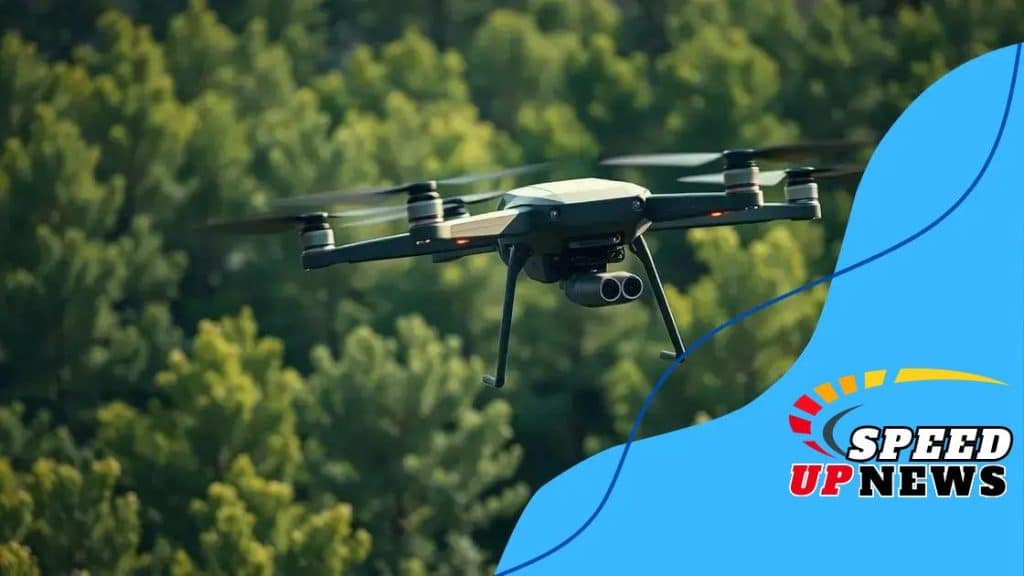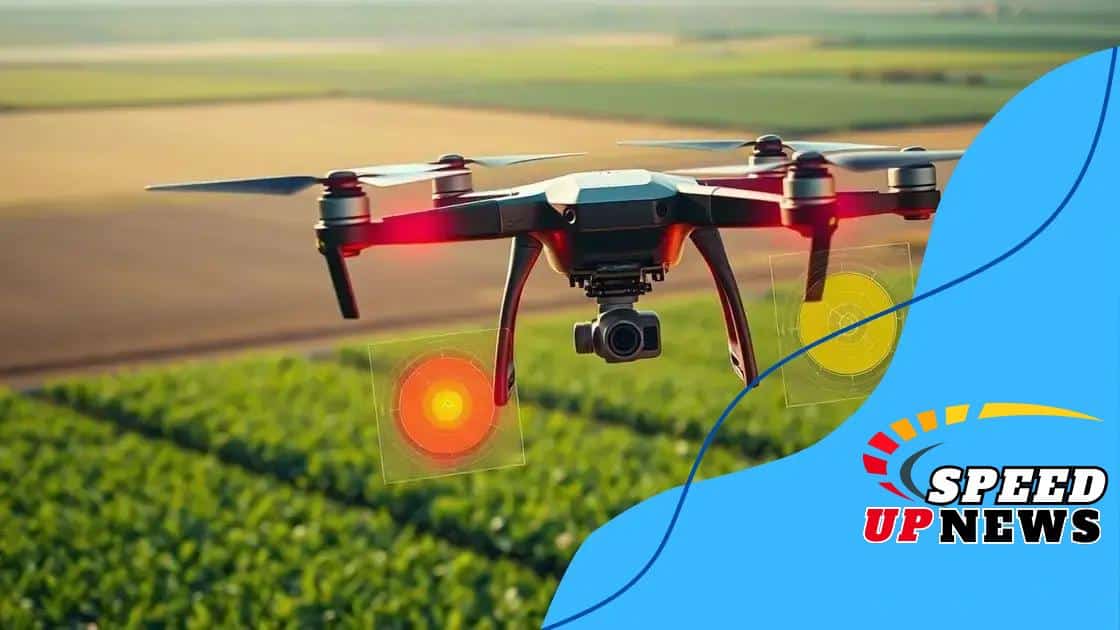Drones in climate change monitoring and research

Drones in climate change monitoring provide efficient data collection and innovative solutions for environmental research, enhancing our understanding of climate impacts through real-time analysis and cost-effective methods.
Drones in climate change monitoring are transforming how scientists gather data and analyze environmental shifts. Have you ever wondered how these devices capture vital information about our planet’s health? Let’s dive in!
Overview of drones in environmental research
Drones are revolutionizing the field of environmental research by providing innovative ways to collect and analyze data. Their ability to reach difficult terrains and gather information quickly makes them invaluable for researchers studying climate change and more.
The Role of Drones in Environmental Monitoring
Drones offer unique advantages in monitoring landscapes and ecosystems. They can capture high-resolution images and collect data over large areas efficiently. With their advanced sensors, drones help scientists detect changes in land use, evaluate vegetation health, and monitor wildlife populations.
Key Features of Drones
- Real-time data collection: Drones can transmit data instantly, allowing researchers to make timely decisions.
- Cost-effectiveness: Compared to traditional methods, using drones can significantly reduce research costs.
- Accessibility: Drones can survey remote or hazardous areas that are hard for people to reach.
- Diverse applications: From mapping to thermal imaging, drones serve multiple purposes in environmental studies.
Furthermore, the integration of GPS technology and machine learning allows drones to conduct complex analyses. This technology enables researchers to track changes in real-time, making it easier to understand the effects of climate change.
Many studies are now using drones to assess the impact of natural disasters, monitor deforestation, and evaluate water quality in rivers and lakes. By analyzing the data collected, scientists can develop better strategies for conservation and resource management.
The Future of Drones in Environmental Research
As technology advances, we can expect drones to become even more sophisticated. Innovations such as AI capabilities and enhanced battery life will make them more efficient and effective. The future holds promising opportunities for collaboration between drone technology and environmental science.
In summary, drones are changing the landscape of environmental research. Their versatility, quick data collection, and ability to operate in challenging conditions make them an essential tool for studying our changing environment.
Benefits of drones for climate data collection
Drones are becoming essential in climate data collection because they offer several advantages. The ability to gather precise information quickly and safely is remarkable. Their versatility allows them to be used across various environments, making them invaluable in understanding climate change.
Efficiency in Data Collection
One of the main benefits of drones is their ability to collect data efficiently. They can cover large areas in a short time, capturing images and gathering information that would take traditional methods much longer. This rapid data collection helps researchers respond to climate changes more quickly.
High-Quality Imagery and Data
Drones equipped with advanced sensors can produce high-resolution images and data. This quality is crucial for monitoring environmental changes like deforestation, glacial melting, and land degradation. The precision and quality of the data help scientists analyze trends accurately.
- Cost-effective: Using drones can reduce costs associated with manned flights or ground surveys.
- Real-time feedback: Drones can provide data immediately, allowing for faster decision-making.
- Flexible deployment: Drones can be easily deployed in various environments, from forests to urban settings.
- Improved safety: Drones can access dangerous areas without risking human safety.
Moreover, drones can be programmed to fly in specific patterns, ensuring comprehensive data collection without missing critical areas. The integration of AI technology allows drones to analyze data on the fly, offering insights that can enhance research and policy-making.
As the demand for immediate and accurate climate data grows, drones will likely play an increasingly prominent role in informing climate action. Their ability to deliver data quickly and reliably makes them an essential tool for researchers and policymakers alike.
Innovative applications of drone technology

Drone technology has opened up numerous innovative applications that are changing how we approach various fields. From agriculture to disaster response, drones are proving to be valuable tools in addressing complex challenges.
Applications in Agriculture
One of the most impactful uses of drones is in agriculture. Farmers are utilizing drones to monitor crop health, assess irrigation needs, and even apply pesticides and fertilizers. This technology enables farmers to gather detailed data efficiently, leading to better decision-making.
Disaster Management
Drones are also being used extensively in disaster management. During natural disasters like floods and wildfires, drones can be deployed to assess damage quickly and locate victims. Their ability to reach inaccessible areas ensures that help can be delivered faster, saving lives.
- Aerial mapping: Drones can create detailed maps of disaster-stricken areas, helping responders understand the full extent of the damage.
- Search and rescue: Equipped with thermal cameras, drones can locate individuals in hard-to-reach locations.
- Supply delivery: Drones can deliver essential supplies, such as medical kits or food, to remote or affected areas during emergencies.
- Monitoring recovery: They help in tracking the recovery efforts post-disaster, providing valuable data over time.
Moreover, drones are making significant contributions in urban planning and infrastructure inspection. By providing detailed aerial views, they assist city planners in identifying suitable sites for new developments while ensuring compliance with zoning laws. Additionally, drones are used to inspect bridges, power lines, and pipelines, detecting issues that might not be visible from the ground.
The integration of computer vision and machine learning within drone technology is further enhancing their capabilities. These advancements allow drones to analyze data in real time, making them even more effective across various platforms.
As the technology continues to evolve, we can expect even more groundbreaking applications in fields such as environmental monitoring, wildlife conservation, and energy management. Drones are set to remain a game-changer in how we understand and interact with our environment.
Case studies: Drones in climate change initiatives
Case studies showcasing the use of drones in climate change initiatives reveal their effectiveness in various scenarios. These examples demonstrate how drone technology can enhance data gathering and monitoring, playing a crucial role in understanding and addressing climate-related issues.
Monitoring Deforestation
In the Amazon rainforest, drones have been employed to monitor deforestation and illegal logging activities. Researchers use high-resolution aerial imagery to map changes in land use over time. This data helps conservationists implement strategies to protect endangered areas.
Glacial Retreat Assessment
Another significant application of drones is in monitoring glacial retreat in regions like Greenland and Antarctica. Drones equipped with thermal sensors collect data on ice thickness and movement, providing crucial insights into how global warming affects these vital ecosystems.
- Real-time data collection: Drones deliver immediate feedback on glacial changes, enabling scientists to react swiftly to new information.
- Enhanced accuracy: Drones facilitate more precise measurements than traditional methods, leading to better understanding.
- Cost-effective solutions: Utilizing drones reduces the costs associated with manned aircraft or extensive ground surveys.
- Accessibility: Drones can operate in harsh environments where human access is challenging or impossible.
In coastal regions, drones have been instrumental in monitoring rising sea levels and coastal erosion. Their ability to capture detailed shoreline images enables researchers to analyze changes and develop proactive measures to mitigate flooding risks in vulnerable areas.
Drones are also making strides in agricultural settings. In California, farmers are using drones to monitor crop health in real time, assessing the effects of climate change on yield. By identifying problem areas early, farmers can make adjustments that help sustain food production.
The integration of machine learning with drone technology is further enhancing these studies. Algorithms can analyze vast amounts of data, providing researchers with insights that were previously difficult to obtain.
These case studies illustrate that the application of drones in various climate change initiatives is not just innovative—it can be transformative. As more organizations adopt this technology, we can expect a better understanding of climate impacts and more effective strategies to combat them.
Future of drones in climate research
The future of drones in climate research looks incredibly promising. As technology progresses, these flying devices are becoming more sophisticated and versatile, leading to exciting possibilities in environmental monitoring and data collection.
Advancements in Drone Technology
Future drones will likely feature enhanced features such as longer flight times, higher payload capacities, and improved sensors. These improvements will enable scientists to gather more comprehensive datasets in a single mission. With the integration of machine learning, drones can analyze data in real-time, which will make it easier to identify patterns and respond swiftly to changes in the environment.
Sustainability and Conservation Efforts
The role of drones in promoting sustainability cannot be underestimated. They will be essential in habitat mapping, monitoring wildlife populations, and studying the impacts of climate change on various ecosystems. Furthermore, drone technology could facilitate reforestation efforts by efficiently planting seeds in hard-to-reach areas.
- Collaborative research: Future drones will likely work in teams, communicating with each other to cover large areas and exchange data, boosting research efficiency.
- Multi-spectral imaging: Advanced imaging technologies will allow drones to gather data outside the visible spectrum, providing deeper insights into plant health and land use.
- Integration with satellites: Drones will complement satellite data, providing ground-level insights that enhance the understanding of regional environmental changes.
- Public awareness: Drones can help educate the public about climate issues by providing engaging visuals and interactive data analysis.
Moreover, the increasing affordability of drones will facilitate their use in educational institutions and non-profit organizations. Students and citizens can participate in citizen science projects, contributing to climate research and raising awareness about environmental issues.
As these technologies evolve, regulatory frameworks will need to adapt. Ensuring safe and responsible use of drones in research will be crucial as they become more prevalent in the field of climate science.
Overall, the future of drones in climate research is set to expand dramatically. We can expect these innovations to play a vital role in understanding and combating climate change, providing essential tools for scientists and researchers worldwide.
The future of drones in climate research is bright and full of promise. As technology continues to advance, drones will transform how we collect and analyze climate data. Their versatility allows for innovative applications, ranging from agriculture to disaster management, and they are vital in understanding our changing planet. With improved sensors and real-time data capabilities, drones will enhance research efficiency and accuracy, making them invaluable tools for scientists and researchers. As we move forward, embracing these technologies will be essential to combating climate change and promoting sustainability.
Key Points 🌍
1. Future Prospects: Drones will become more advanced with better sensors and capabilities for climate research.
2. Environmental Impact 🌱: Drones aid in habitat monitoring, reforestation, and wildlife conservation.
3. Innovative Data Collection 📊: They enable real-time data collection and analysis for more informed decisions.
4. Cost-Effectiveness 💰: Drones reduce costs compared to traditional data collection methods.
5. Citizen Involvement 🤝: More involvement in climate data projects as drones become accessible.
FAQ – Frequently Asked Questions about Drones in Climate Research
How do drones help in climate change research?
Drones collect data efficiently and accurately, allowing researchers to monitor environmental changes and impacts of climate change in real time.
What types of data can drones gather?
Drones can gather various types of data, including high-resolution images, thermal data for temperature analysis, and multi-spectral data for assessing vegetation health.
Are drones cost-effective for environmental monitoring?
Yes, drones significantly reduce the costs associated with traditional methods of data collection, making them a valuable tool for researchers.
How can citizens get involved in climate research using drones?
With the increasing accessibility of drone technology, citizens can participate in projects that involve data collection and analysis, contributing to important climate research.





